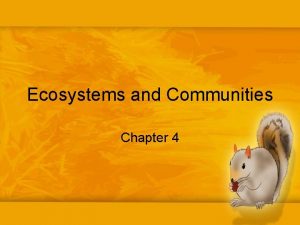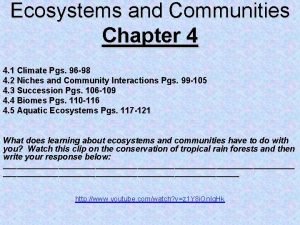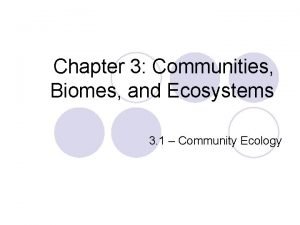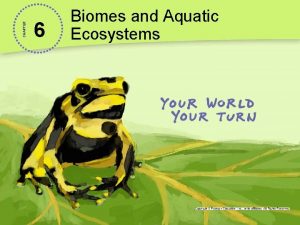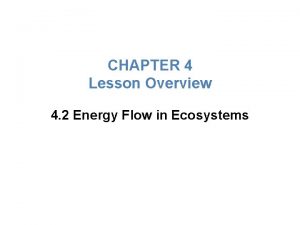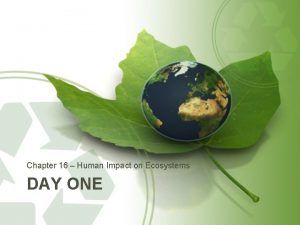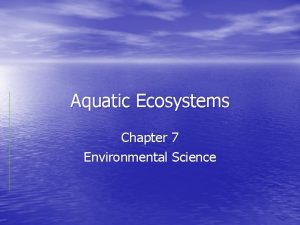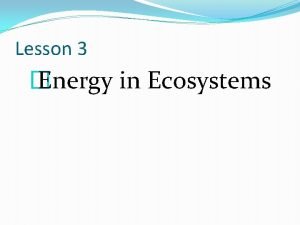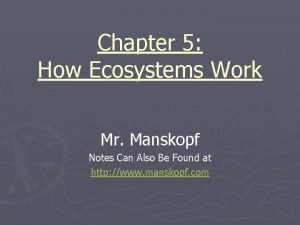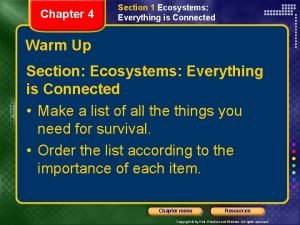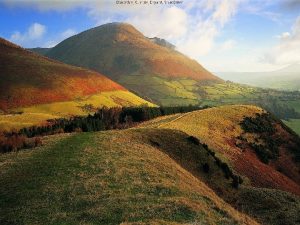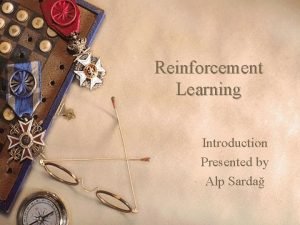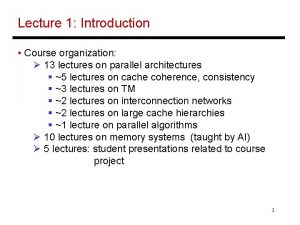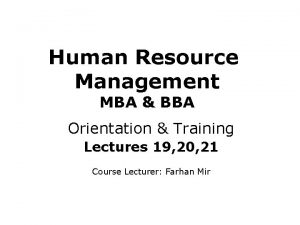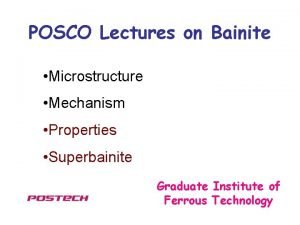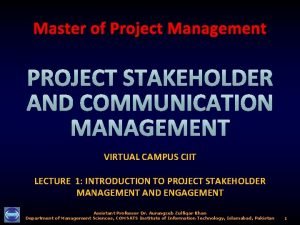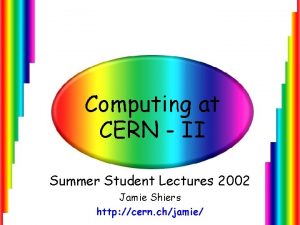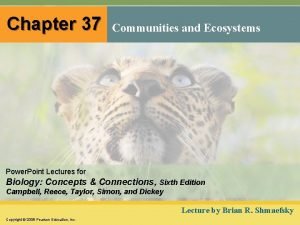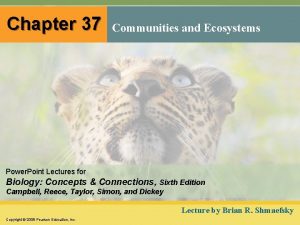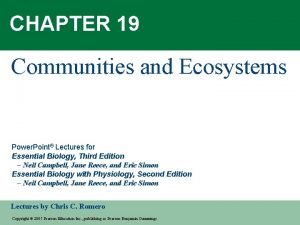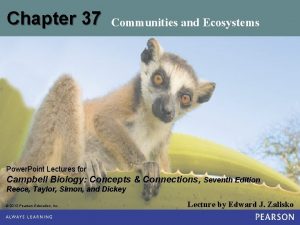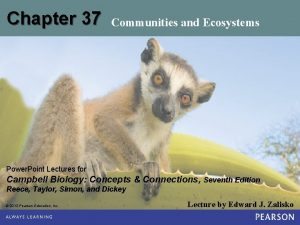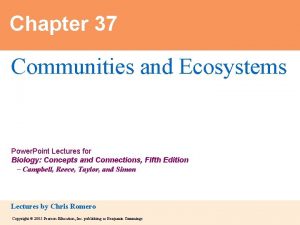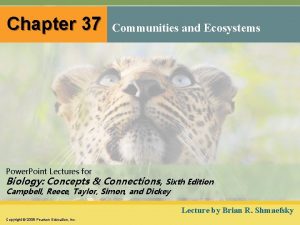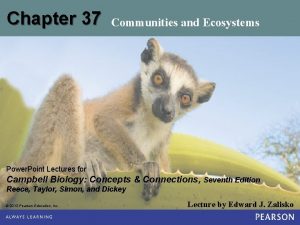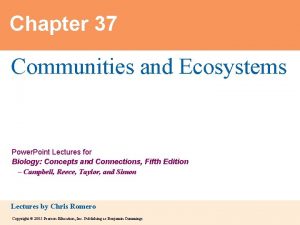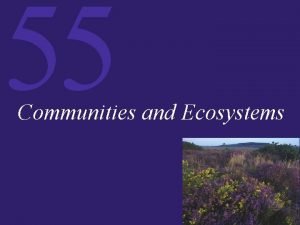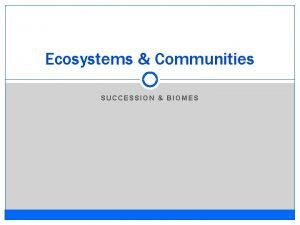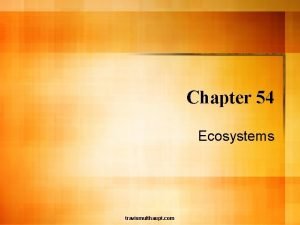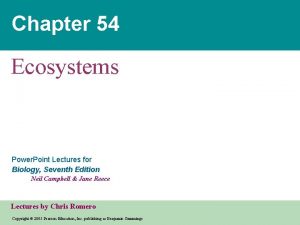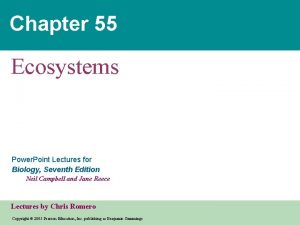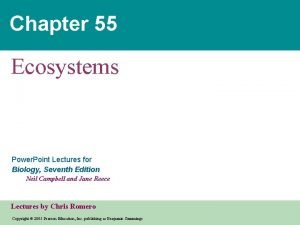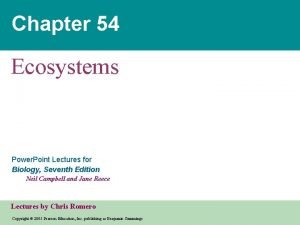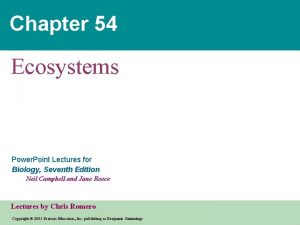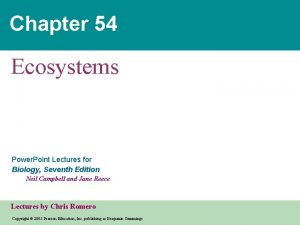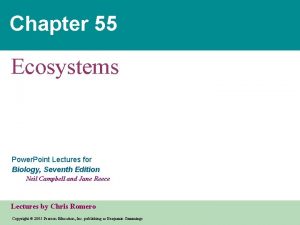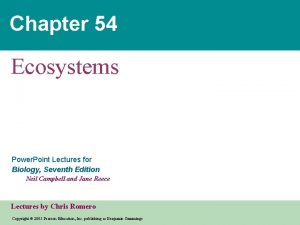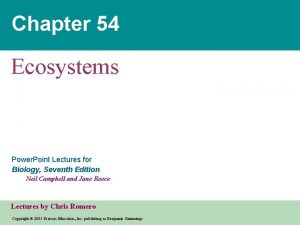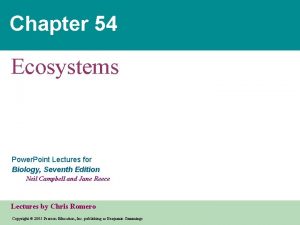Chapter 37 Communities and Ecosystems Power Point Lectures





































































- Slides: 69

Chapter 37 Communities and Ecosystems Power. Point Lectures for Biology: Concepts and Connections, Fifth Edition – Campbell, Reece, Taylor, and Simon Lectures by Chris Romero Copyright © 2005 Pearson Education, Inc. publishing as Benjamin Cummings

Dining In • Community structure and function depend on the interactions among organisms – Example: Apanteles glomeratus wasp, Pieris rapae butterfly, and other wasps • Ecosystem structure and function depend on the interactions of the community with its abiotic environment Copyright © 2005 Pearson Education, Inc. publishing as Benjamin Cummings





STRUCTURAL FEATURES OF COMMUNITIES 37. 1 A community includes all the organisms inhabiting a particular area • Biological community: an assemblage of all the populations of organisms living close enough together for potential interaction • Key characteristics of a community – Species diversity: variety of different kinds of organisms • Species richness • Relative abundance Copyright © 2005 Pearson Education, Inc. publishing as Benjamin Cummings

– Dominant species – Response to disturbances – Trophic structure: feeding relationships among species Copyright © 2005 Pearson Education, Inc. publishing as Benjamin Cummings


37. 2 Competition may occur when a shared resource is limited • Interspecific competition may play a major role in structuring a community – Two species competing for the same limited resource – May inhibit growth of one or both species Copyright © 2005 Pearson Education, Inc. publishing as Benjamin Cummings

• Competitive exclusion principle – Two species cannot coexist in a community if their niches are identical • Niche: species' total use of biotic and abiotic resources – Two possible results • Less competitive species will be driven to local extinction • Resource partitioning may evolve Copyright © 2005 Pearson Education, Inc. publishing as Benjamin Cummings

LE 37 -2 a

LE 37 -2 b

37. 3 Predation leads to diverse adaptations in both predator and prey • Predation is an interaction between species in which predator kills and eats prey • Adaptations of both tend to be refined through natural selection – Camouflage – Chemical defense Video: Seahorse Camouflage Copyright © 2005 Pearson Education, Inc. publishing as Benjamin Cummings


Copyright © 2005 Pearson Education, Inc. publishing as Benjamin Cummings

– Batesian mimicry • Palatable species mimics an unpalatable model – Mullerian mimicry • Two unpalatable species mimic each other Copyright © 2005 Pearson Education, Inc. publishing as Benjamin Cummings



37. 4 Predation can maintain diversity in a community • Keystone species – Exerts strong control on community structure because of its ecological niche • Keystone predator – May maintain community diversity by reducing numbers of the strongest competitors – Removal can cause major changes in community dynamics Copyright © 2005 Pearson Education, Inc. publishing as Benjamin Cummings



37. 5 Herbivores and the plants they eat have various adaptations • Herbivores are animals that eat plants or algae – Have adaptations for locating and eating vegetation • Plants have evolved defenses against herbivores – Toxic chemicals – Physical defenses (spines, thorns) Copyright © 2005 Pearson Education, Inc. publishing as Benjamin Cummings

• Some herbivore-plant interactions illustrate coevolution – Reciprocal evolutionary adaptations – Change in one species acts as a new selective force on another species Copyright © 2005 Pearson Education, Inc. publishing as Benjamin Cummings

LE 37 -5 Eggs Sugar deposits

37. 6 Symbiotic relationships help structure communities • Symbiotic relationship: interaction between two or more species that live in direct contact – Parasitism • Parasite lives on or near its host • Parasite obtains nourishment at the expense of host • Includes pathogens that may inflict lethal harm on host Copyright © 2005 Pearson Education, Inc. publishing as Benjamin Cummings


• Commensalism – One species benefits without significantly affecting the other – Few absolute cases documented • Mutualism – Both partners benefit Copyright © 2005 Pearson Education, Inc. publishing as Benjamin Cummings


Video: Clownfish and Anemone Copyright © 2005 Pearson Education, Inc. publishing as Benjamin Cummings

37. 7 Disturbance is a prominent feature of most communities • Disturbances are characteristic of most biological communities – Events such as fire, storms, floods – Damage communities – Remove organisms from communities – Alter the availability of resources – Can have positive effects Copyright © 2005 Pearson Education, Inc. publishing as Benjamin Cummings

• Ecological succession is a transition in community species composition following a major disturbance – Primary succession: gradual colonization of barren rocks – Secondary succession: occurs after a disturbance has destroyed a community but left the soil intact Copyright © 2005 Pearson Education, Inc. publishing as Benjamin Cummings

LE 37 -7 Retreating glacier with moraine in the foreground Dryas stage Spruce starting to appear in the alder and cottonwood forest Spruce and hemlock forest

TALKING ABOUT SCIENCE 37. 8 Fire specialist Max Moritz discusses the role of fire in ecosystems • Dr. Max Moritz studies fire in chaparral ecosystems • Fire is a key abiotic factor in many ecosystems – Important in nutrient cycling – Creates conditions for regeneration of many plants • Dr. Moritz hopes to help people coexist with cycles of weather, vegetation, growth, and fire Copyright © 2005 Pearson Education, Inc. publishing as Benjamin Cummings



37. 9 Trophic structure is a key factor in community dynamics • Trophic structure: a pattern of feeding relationships consisting of several different levels • Food chain: sequence of food transfer up the trophic levels – Moves chemical nutrients and energy Copyright © 2005 Pearson Education, Inc. publishing as Benjamin Cummings

• Producers – Autotrophs that support all other trophic levels – Plants on land – In water, mainly photosynthetic protists and cyanobacteria • Primary consumers – Herbivores that eat plants, algae, or phytoplankton Copyright © 2005 Pearson Education, Inc. publishing as Benjamin Cummings

• Secondary, tertiary, and quaternary consumers – Eat consumers from the level below them • Detritivores (decomposers) – Animal scavengers, fungi, and prokaryotes – Derive energy from detritus produced at all trophic levels – Decomposition is essential for recycling nutrients in ecosystems Video: Shark Eating Seal Copyright © 2005 Pearson Education, Inc. publishing as Benjamin Cummings

LE 37 -9 Trophic level Quaternary consumers Hawk Killer whale Tertiary consumers Snake Tuna Secondary consumers Herring Mouse Primary consumers Zooplankton Grasshopper Producers Plant A terrestrial food chain Phytoplankton An aquatic food chain

37. 10 Food chains interconnect, forming food webs • A food web is a more realistic view of trophic structure – Consumers usually eat more than one type of food – Each food type is consumed by more than one type of consumer Copyright © 2005 Pearson Education, Inc. publishing as Benjamin Cummings

LE 37 -10 Quaternary, tertiary, and secondary consumers Tertiary and secondary consumers Secondary and primary consumers Producers (plants)

ECOSYSTEM STRUCTURE AND DYNAMICS 37. 11 Ecosystem ecology emphasizes energy flow and chemical cycling • An ecosystem consists of all the organisms in a community and the abiotic factors with which they interact • Ecosystem dynamics involve two processes – Energy flow through the components of the ecosystem – Chemical cycling within the ecosystem Copyright © 2005 Pearson Education, Inc. publishing as Benjamin Cummings

LE 37 -11 Chemical cycling Energy flow Chemical energy Light energy Heat energy Chemical elements

37. 12 Primary production sets the energy budget for ecosystems • Primary production: amount of solar energy converted by producers to chemical energy in biomass – Biomass: amount of organic material in an ecosystem – Net primary production: amount of biomass produced minus amount used by producers in cellular respiration – Varies greatly among ecosystems Copyright © 2005 Pearson Education, Inc. publishing as Benjamin Cummings

LE 37 -12 Open ocean Estuary Algal beds and coral reefs Desert and semidesert scrub Tundra Temperate grassland Cultivated land Boreal forest (taiga) Savanna Temperate deciduous forest Tropical rain forest 0 500 1, 000 1, 500 2, 000 Average net primary productivity (g/m 2/yr) 2, 500

37. 13 Energy supply limits the length of food chains • Only about 10% of the energy stored at each trophic level is available to the next level – Pyramid of production shows loss of energy from producers to higher trophic levels – Amount of energy available to top-level consumers is relatively small • Most food chains have only three to five levels Copyright © 2005 Pearson Education, Inc. publishing as Benjamin Cummings

LE 37 -13 Tertiary consumers Secondary consumers Primary consumers Producers 10 kcal 100 kcal 1, 000 kcal 10, 000 kcal 1, 000 kcal of sunlight

CONNECTION 37. 14 A production pyramid explains why meat is a luxury for humans • Human meat or fish eaters are tertiary or quaternary consumers • Humans eating grain have ten times more energy available than when they process the same amount of grain through meat • Using land to raise animals consumes more resources than using the land to cultivate crops Copyright © 2005 Pearson Education, Inc. publishing as Benjamin Cummings

LE 37 -14 Trophic level Human meat-eaters Secondary consumers Primary consumers Human vegetarians Corn Producers Cattle Corn

37. 15 Chemicals are recycled between organic matter and abiotic reservoirs • Biogeochemical cycles – Cycle nutrients through both biotic and abiotic components – Can be local or global Copyright © 2005 Pearson Education, Inc. publishing as Benjamin Cummings

LE 37 -15 Consumers Producers Detritivores Nutrients available to producers Abiotic reservoir

37. 16 Water moves through the biosphere in a global cycle – Solar energy drives the global water cycle – Precipitation – Evaporation – Transpiration – Water cycles between the land, oceans, and atmosphere – Forest destruction and irrigation affect the water cycle Copyright © 2005 Pearson Education, Inc. publishing as Benjamin Cummings

LE 37 -16 Transport over land Solar energy Net movement of water vapor by wind Precipitation over ocean Evaporation from ocean Precipitation over land Evaporation and transpiration from land Percolation through soil Runoff and groundwater

37. 17 The carbon cycle depends on photosynthesis and respiration • Carbon cycles through the atmosphere, fossil fuels, and dissolved carbon in oceans – Taken from the atmosphere by photosynthesis – Used to make organic molecules – Decomposed by detritivores – Returned to the atmosphere by cellular respiration • Burning of wood and fossil fuels is raising the level of CO 2 in the atmosphere Copyright © 2005 Pearson Education, Inc. publishing as Benjamin Cummings

LE 37 -17 CO 2 in atmosphere Photosynthesis Cellular respiration Burning of fossil fuels and wood Higher-level Primary consumers Carbon compounds in water Detritus Decomposition

37. 18 The nitrogen cycle relies heavily on bacteria • Atmospheric N 2 is not available to plants – Soil bacteria convert gaseous N 2 to usable ammonium (NH 4+) and nitrate (NO 3 -) – Some NH 4+ and NO 3 - are made by chemical reactions in the atmosphere • Human activity is altering nitrogen cycle balance in many areas – Sewage treatment and fertilization Copyright © 2005 Pearson Education, Inc. publishing as Benjamin Cummings

LE 37 -18 Nitrogen in atmosphere (N 2) Nitrogen fixation Assimilation by plants Nitrogen-fixing bacteria in root nodules of legumes Detritivores Decomposition Ammonium (NH 4 ) Nitrogen-fixing soil bacteria Denitrifying Nitrates bacteria (NO 3–) Nitrifying bacteria

37. 19 The phosphorus cycle depends on the weathering of rock • Phosphorus and other soil minerals are recycled locally • Weathering of rock adds PO 43 - to soil – Slow process makes amount of phosphorus available to plants low • Human activity has created phosphate pollution of water Copyright © 2005 Pearson Education, Inc. publishing as Benjamin Cummings

LE 37 -19 Rain Geologic uplift of rocks Weathering of rocks Plants Runoff Consumption Plant uptake of PO 43– Sedimentation Soil Leaching Decomposition

ECOSYSTEM ALTERATION CONNECTION 37. 20 Ecosystem alteration can upset chemical cycling • The Hubbard Brook Experimental Forest is a long-term study of nutrient cycling – Natural conditions – Water loss balanced between runoff and transpiration/evaporation – Flow of nutrients in and out of watersheds nearly balanced Copyright © 2005 Pearson Education, Inc. publishing as Benjamin Cummings

– Logged and sprayed watershed • Runoff increased 30 -40% • Net loss of nutrients was huge • Nitrate concentration in creek was 60 times greater – Other long-term findings • Acid precipitation has resulted in calcium loss • Forest plants are not adding new growth because of calcium deficiency Copyright © 2005 Pearson Education, Inc. publishing as Benjamin Cummings



Nitrate concentration in runoff (mg/L) LE 37 -20 c 80. 0 Deforested 60. 0 40. 0 20. 0 4. 0 3. 0 Completion of tree cutting Control 2. 0 1965 1966 1967 1968

TALKING ABOUT SCIENCE 37. 21 David Schindler talks about the effects of nutrients on freshwater ecosystems • Dr. David Schindler was involved in environmental research that resulted in the banning of phosphates in detergents • Nutrient runoff from agricultural lands and large livestock operations may cause excessive algal growth • This cultural eutrophication reduces species diversity and harms water quality Copyright © 2005 Pearson Education, Inc. publishing as Benjamin Cummings

• A combination of factors threaten freshwater ecosystems – Acid precipitation – Climate warming – Changes in land use Copyright © 2005 Pearson Education, Inc. publishing as Benjamin Cummings


Figure 37 -21 b Copyright © 2005 Pearson Education, Inc. publishing as Benjamin Cummings
 Chapter 4 ecosystems and communities
Chapter 4 ecosystems and communities Chapter 4 ecosystems and communities
Chapter 4 ecosystems and communities Orderly natural changes and species replacements
Orderly natural changes and species replacements What are the steps of secondary succession
What are the steps of secondary succession Power system lectures
Power system lectures Draw power triangle
Draw power triangle The chaparral biome is best characterized by _______.
The chaparral biome is best characterized by _______. Why biomes are important
Why biomes are important Phosphorus cycle pearson education
Phosphorus cycle pearson education Chapter 42 ecosystems and energy
Chapter 42 ecosystems and energy Chapter 3 lesson 3 biomes and aquatic ecosystems
Chapter 3 lesson 3 biomes and aquatic ecosystems Chapter 55 ecosystems and restoration ecology
Chapter 55 ecosystems and restoration ecology Powerbi in powerpoint
Powerbi in powerpoint Point point power
Point point power Utilities and energy lecture
Utilities and energy lecture What is text linguistics
What is text linguistics Molecular biology lectures
Molecular biology lectures Chapter 3 section 3 aquatic ecosystems
Chapter 3 section 3 aquatic ecosystems Chapter 4 lesson 2 energy flow in ecosystems answer key
Chapter 4 lesson 2 energy flow in ecosystems answer key Chapter 16 human impact on ecosystems
Chapter 16 human impact on ecosystems Limestone ridges built by tiny animals
Limestone ridges built by tiny animals Chapter 4 lesson 2 energy flow in ecosystems answer key
Chapter 4 lesson 2 energy flow in ecosystems answer key Chapter 7 aquatic ecosystems test answers
Chapter 7 aquatic ecosystems test answers Chapter 5 how ecosystems work study guide
Chapter 5 how ecosystems work study guide Chapter 16 human impact on ecosystems
Chapter 16 human impact on ecosystems Section 1 ecosystems everything is connected answer key
Section 1 ecosystems everything is connected answer key Unit 5 ecology
Unit 5 ecology Rick trebino
Rick trebino Lectures paediatrics
Lectures paediatrics Data mining lectures
Data mining lectures Advanced medicinal chemistry
Advanced medicinal chemistry Uva powerpoint
Uva powerpoint Cs614 short lectures
Cs614 short lectures Activity identification approaches in spm
Activity identification approaches in spm Radio astronomy lectures
Radio astronomy lectures Dr sohail lectures
Dr sohail lectures Web engineering lectures ppt
Web engineering lectures ppt Do words have power
Do words have power Frcr physics lectures
Frcr physics lectures Frcr physics lectures
Frcr physics lectures Cs106b lectures
Cs106b lectures Differentiation of rbc
Differentiation of rbc Aerodynamics lectures
Aerodynamics lectures Theory of translation lectures
Theory of translation lectures Theory of translation lectures
Theory of translation lectures Digital logic design lectures
Digital logic design lectures Jim kurose
Jim kurose Hegel philosophy
Hegel philosophy Nuclear medicine lectures
Nuclear medicine lectures Cs106b
Cs106b Cdeep lectures
Cdeep lectures Oral communication 3 lectures text
Oral communication 3 lectures text C programming lectures
C programming lectures Haematology lectures
Haematology lectures Bureau of lectures
Bureau of lectures Trend lectures
Trend lectures Theory of translation lectures
Theory of translation lectures Reinforcement learning lectures
Reinforcement learning lectures 13 lectures
13 lectures Reinforcement learning lectures
Reinforcement learning lectures Bba lectures
Bba lectures Medical emergency student lectures
Medical emergency student lectures Hematology lectures for medical student
Hematology lectures for medical student Rcog eportfolio
Rcog eportfolio Bhadeshia lectures
Bhadeshia lectures Ota resident lectures
Ota resident lectures Comsats virtual campus lectures
Comsats virtual campus lectures Hugh blair lectures on rhetoric
Hugh blair lectures on rhetoric Cern summer student lectures
Cern summer student lectures Pathology lectures for medical students
Pathology lectures for medical students
